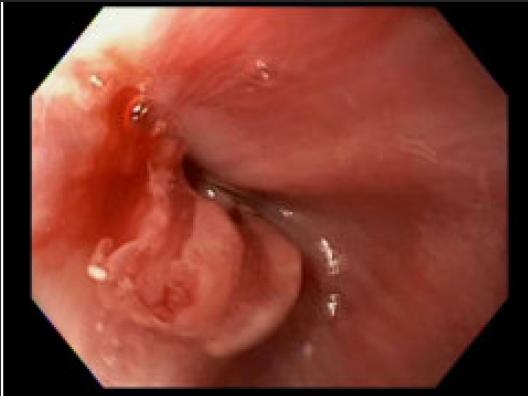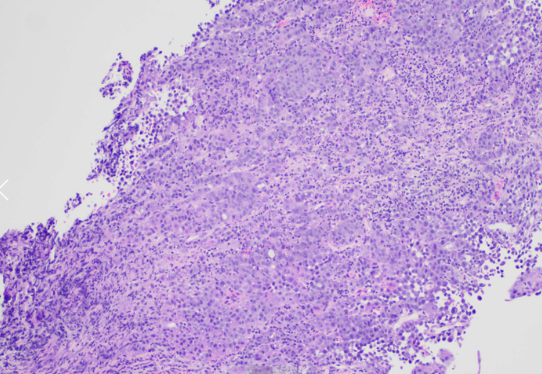Monday Poster Session
Category: Esophagus
P2852 - Poorly Differentiated Esophageal Adenocarcinoma in a 36-Year-Old Female: A Case Report and Literature Review
Monday, October 27, 2025
10:30 AM - 4:00 PM PDT
Location: Exhibit Hall
.jpg)
Farhan Mohiuddin, MD
Louisiana State University School of Medicine
New Orleans, LA
Presenting Author(s)
Farhan Mohiuddin, MD1, Katherine Westbrook Cates, DO1, Ross Dies, MD2, Autumn Collins, MD1, Kevin Cowley, MD3
1Louisiana State University School of Medicine, New Orleans, LA; 2Louisiana State University School of Medicine, Shreveport, LA; 3Ochsner Health System, New Orleans, LA
Introduction: Esophageal cancer is the eighth most common cancer globally and the sixth leading cause of cancer-related death. Squamous cell carcinoma is the predominant subtype worldwide; however, in North America, Western Europe, and Australia, adenocarcinoma is more common. Esophageal cancer is nearly three times more frequent in men and five times more common in Caucasians than in African Americans, Asians, or Native Americans. The median age of diagnosis is 64–74, with only 3.2% of cases occurring under age 45. We present a case of poorly differentiated esophageal adenocarcinoma in a 36-year-old Hispanic female.
Case Description/
Methods: A 36-year-old Hispanic female with no past medical history presented to the ED with nausea, vomiting, and chest pain. She reported one month of solid food dysphagia, which progressed to include liquids over two weeks. She noted a ten-pound weight loss and denied tobacco, alcohol, NSAID use, or family history of malignancy.
Initial labs revealed hemoglobin 7.9 and hematocrit 27.6, with otherwise unremarkable labs. CT chest showed esophageal wall thickening and an abnormal gastroesophageal junction. EGD revealed a near-obstructing distal esophageal mass and a mass at the gastroesophageal junction. Biopsies confirmed poorly differentiated adenocarcinoma. She was transferred to a tertiary center for stent placement and possible esophagogastrectomy with colonic interposition.
Discussion: In the U.S., most esophageal adenocarcinomas are poorly differentiated at diagnosis, unlike squamous cell carcinomas, which are often moderately differentiated. Standard treatment includes chemoradiotherapy; surgery is performed in only 26.6% of cases, though more commonly in adenocarcinoma. One- and five-year survival for esophageal adenocarcinoma is 54.4% and 23.4%, with a median survival of 15 months. Known risk factors include male gender, GERD, Barrett’s esophagus, obesity, smoking, alcohol, NSAID use, and genetics. This case is notable for the patient’s lack of typical risk factors. Current screening is advised for patients with GERD refractory to medical therapy.

Figure: Figure 1: Endoscopic image of adenocarcinoma of the lower esophagus

Figure: Figure 2: Histopathological image of adenocarcinoma from the endoscopic specimen.
Disclosures:
Farhan Mohiuddin indicated no relevant financial relationships.
Katherine Westbrook Cates indicated no relevant financial relationships.
Ross Dies indicated no relevant financial relationships.
Autumn Collins indicated no relevant financial relationships.
Kevin Cowley indicated no relevant financial relationships.
Farhan Mohiuddin, MD1, Katherine Westbrook Cates, DO1, Ross Dies, MD2, Autumn Collins, MD1, Kevin Cowley, MD3. P2852 - Poorly Differentiated Esophageal Adenocarcinoma in a 36-Year-Old Female: A Case Report and Literature Review, ACG 2025 Annual Scientific Meeting Abstracts. Phoenix, AZ: American College of Gastroenterology.
1Louisiana State University School of Medicine, New Orleans, LA; 2Louisiana State University School of Medicine, Shreveport, LA; 3Ochsner Health System, New Orleans, LA
Introduction: Esophageal cancer is the eighth most common cancer globally and the sixth leading cause of cancer-related death. Squamous cell carcinoma is the predominant subtype worldwide; however, in North America, Western Europe, and Australia, adenocarcinoma is more common. Esophageal cancer is nearly three times more frequent in men and five times more common in Caucasians than in African Americans, Asians, or Native Americans. The median age of diagnosis is 64–74, with only 3.2% of cases occurring under age 45. We present a case of poorly differentiated esophageal adenocarcinoma in a 36-year-old Hispanic female.
Case Description/
Methods: A 36-year-old Hispanic female with no past medical history presented to the ED with nausea, vomiting, and chest pain. She reported one month of solid food dysphagia, which progressed to include liquids over two weeks. She noted a ten-pound weight loss and denied tobacco, alcohol, NSAID use, or family history of malignancy.
Initial labs revealed hemoglobin 7.9 and hematocrit 27.6, with otherwise unremarkable labs. CT chest showed esophageal wall thickening and an abnormal gastroesophageal junction. EGD revealed a near-obstructing distal esophageal mass and a mass at the gastroesophageal junction. Biopsies confirmed poorly differentiated adenocarcinoma. She was transferred to a tertiary center for stent placement and possible esophagogastrectomy with colonic interposition.
Discussion: In the U.S., most esophageal adenocarcinomas are poorly differentiated at diagnosis, unlike squamous cell carcinomas, which are often moderately differentiated. Standard treatment includes chemoradiotherapy; surgery is performed in only 26.6% of cases, though more commonly in adenocarcinoma. One- and five-year survival for esophageal adenocarcinoma is 54.4% and 23.4%, with a median survival of 15 months. Known risk factors include male gender, GERD, Barrett’s esophagus, obesity, smoking, alcohol, NSAID use, and genetics. This case is notable for the patient’s lack of typical risk factors. Current screening is advised for patients with GERD refractory to medical therapy.

Figure: Figure 1: Endoscopic image of adenocarcinoma of the lower esophagus

Figure: Figure 2: Histopathological image of adenocarcinoma from the endoscopic specimen.
Disclosures:
Farhan Mohiuddin indicated no relevant financial relationships.
Katherine Westbrook Cates indicated no relevant financial relationships.
Ross Dies indicated no relevant financial relationships.
Autumn Collins indicated no relevant financial relationships.
Kevin Cowley indicated no relevant financial relationships.
Farhan Mohiuddin, MD1, Katherine Westbrook Cates, DO1, Ross Dies, MD2, Autumn Collins, MD1, Kevin Cowley, MD3. P2852 - Poorly Differentiated Esophageal Adenocarcinoma in a 36-Year-Old Female: A Case Report and Literature Review, ACG 2025 Annual Scientific Meeting Abstracts. Phoenix, AZ: American College of Gastroenterology.
